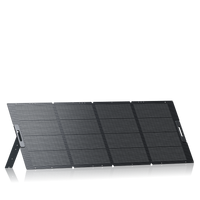Your cart is empty
Shop our productsAlthough electric bills are sometimes seen as confusing and overwhelming, they don't need to be! Understanding and demystifying Indiana's electric bills is essential to ensure you're paying a fair rate and not overspending. This article will break down exactly what to look out for when reading and interpreting an electric bill, as well as providing helpful tips and tricks on how to lower your costs and maximize your savings. Knowing what to look for, and how to lower your electric bills can help you make the most of your money and have a better handle on your overall budget.
Overview of the Average Electric Bill in Indiana
The average electricity bill in Indiana can be quite costly per month, and even more so per year. In 2019, the typical household in Indiana paid an average of $119.41 per month for their electricity. This equates to $1,431.92 per year for their electricity.
The calculation of an electric bill is based on three main factors: the type of customer, the customer’s total electricity usage for the month and the rate per kilowatt-hour (kWh). For example, if a customer’s total electricity usage for the month was 500 kWh and the rate was $0.10 per kWh, their total electricity bill for the month would be $50.00.
In addition, customers in Indiana may need to pay additional fees that are not associated with their electricity usage. For example, customers may be charged an additional fee for the customer charge, the basic service charge, the electric security plan, a franchise fee or a transmission and distribution service charge. Each of these charges will vary from one electric company to the other.
Indiana houses are also subject to peak and off-peak electricity rates. Peak rates occur during periods of high energy demand, typically during the summer months from 5 am to 11 pm. Off-peak rates occur during overnight hours from 11 pm to 5 am. Peak rates are usually higher than off-peak rates.
On the other hand, customers in Indiana may also qualify for special discounts or programs that reduce their monthly costs. For example, some companies offer low-income assistance programs, renewable energy sources, special time-of-use rates, prepaid plans or special discounts for seniors. These incentives can help customers lower their electricity bills each month.

How have Indiana Electricity Bills Changed Since Last Year?
Indiana residents have seen a decrease in electricity costs over the past year, with the state's average price of electricity dropping for the fourth consecutive year. In 2020, the average statewide rate for electricity was about $.096 per kilowatt-hour (kWh). This is a 4.2% decrease over the previous year, and almost 12% lower than the average price of electricity in Indiana five years ago.Although the average price of electricity in Indiana has been decreasing, this does not mean all customers will pay lower bills. Most of the state's largest utilities, including Duke Energy and NIPSCO, have implemented increases in their base rates, which create higher fixed charges on the customer's electric bill. This is one of the contributing factors in the increase in electric bills for some customers, even when the price of electricity is lower.
In addition to the base charges, customers will also see increases on their electric bills due to changes in energy usage. During periods of higher energy usage, such as during the summer, customers could potentially see higher electric bills. This is due to the fact that during times of peak usage, the cost of electricity increases.
To view the current electricity prices in Indiana, customers can visit the Indiana Utility Regulatory Commission's website or the website of their specific utility. Customers can also sign up for alerts through their utility and receive real-time notifications when electricity prices change. This is a great way for customers to stay informed and track their electricity costs. Additionally, customers can also find energy-efficiency tips on their utility's websites, which can help them lower their electricity costs.

Why is my electric bill so high in Indiana?
There are several reasons why electricity bills in Indiana can be higher than in other states. These can include factors such as the weather, the age of the electrical network and appliances in Indiana, and the energy supplier. Indiana has higher temperatures than some other parts of the US, and the older electrical systems require more energy to operate. Additionally, electricity rates can vary from supplier to supplier and even by region. Understanding the different factors that affect your energy costs and how to lower them can help you save money on your energy bills in Indiana.
Weather affects energy bills because high temperatures require a greater demand for energy to keep people and businesses cool. Warmer months typically mean higher electric bills as more energy is consumed to run air conditioners. Other factors such as the insulation of your home and whether you are using energy efficient appliances can further impact your energy bill.
The age and condition of your electrical network also affects your electric bill. Old wiring and inefficient appliances use more energy and cost more. Similarly, certain appliances can consume more energy than others, resulting in higher electricity bills. Energy-saving measures such as switching off appliances when not in use can help reduce costs.
your electricity provider has an impact on your electric bill. Different suppliers may offer different rates, so it’s important to shop around and compare prices before committing to a provider. Additionally, certain suppliers like energy cooperatives may offer reduced rates to members, so it pays to do your research.
understanding the different factors that contribute to your electricity bill in Indiana will help you identify areas where you can save money. Taking steps to reduce your energy consumption, such as switching off unused appliances or using energy-efficient models, can help lower your electricity bills in the state. >Comparing the cost of electricity from Indiana to other states is useful in understanding how much of an impact Indiana's electricity rates have on residents. In order to accomplish this, one should consider the following ten criteria: average monthly cost, Tier 1 and Tier 2 rates, renewable energy sources, taxes and fees, cost per kilowatt-hour, peak hours, and customer service. By evaluating these items, one can assess how competitive Indiana's electricity rates are in comparison to other states.
Comparison of Electricity Prices in Indiana and Other States
Average Monthly Cost: The average monthly cost of electricity in Indiana is slightly higher than the national average at approximately $100.Tier 1 and Tier 2 Rates: Tier 1 rate is the rate charged to residential customers during off-peak hours while Tier 2 rate is the rate charged to residential customers during peak hours. The average Tier 1 rate in Indiana is approximately 13 cents per kilowatt-hour (kWh), while the average Tier 2 rate is 22 cents per kWh.
Renewable Energy Sources: Indiana is a laggard in renewable energy sources with only about 6% of its electricity coming from renewable sources such as solar and wind.
Taxes and Fees: Indiana has relatively low taxes and fees associated with electricity, with an average of approximately $18 per month.
Cost per Kilowatt-Hour: The cost per kWh in Indiana is roughly 12 cents, slightly higher than the national average of about 11 cents.
Peak Hours: Peak hours in Indiana are between 2PM and 7PM, where the rate charged to residential customers is higher than during off-peak hours.
Customer Service: Indiana has relatively average customer service ratings when it comes to electricity.
| State | Average Monthly Cost | Tier 1 rate (off peak) | Tier 2 rate (peak) | Renewable energy | Taxes and Fees | Cost per kWh |
|---|---|---|---|---|---|---|
| Indiana | $100 | 13 cents | 22 cents | 6% | $18 | 12 cents |
| California | $108 | 14 cents | 22 cents | 33% | $17 | 15 cents |
| New York | $122 | 20 cents | 36 cents | 31% | $17 | 14 cents |
As the table above shows, Indiana does not stand out when it comes to the cost of electricity when compared to California and New York. Indiana's average monthly cost is slightly higher than the national average, and its Tier 1 and Tier 2 rates are slightly higher than the national average. Additionally, Indiana lags behind other states in terms of renewable energy sources, and its taxes and fees are about average when compared to other states. Indiana's cost per kWh is slightly higher than the national average. All in all, Indiana's electricity costs fall in line with the national average.

Who provides electricity to Indiana?
Indiana is serviced by five major electricity providers. These companies provide electricity to both residential and business customers in the state.
Vectren: Vectren is one of Indiana’s largest electric utility companies. It serves more than one million customers in southwestern Indiana. Vectren is a subsidiary of CenterPoint Energy and provides electricity and gas service in Indiana.Duke Energy: Duke Energy is a Fortune 500 company that serves more than 2 million customers in Indiana. It offers electricity, natural gas, and transmission services to customers in Indiana and other Midwest states.
NIPSCO: NIPSCO is the largest gas and electric utility in Indiana, serving more than 800,000 customers. The company provides natural gas and electric service to customers in northern Indiana.
Indianapolis Power & Light: Indianapolis Power & Light, or IPL, serves nearly 500,000 customers in central Indiana. The company provides electricity to commercial, industrial, and municipal customers in the Indianapolis metropolitan area.
Indiana Michigan Power: Indiana Michigan Power is a subsidiary of American Electric Power and provides electricity to nearly 520,000 people in northern Indiana and southern Michigan. It operates two coal-fired power plants and an electric transmission system.
To pay less for electricity in Indiana, there are a few key tips and strategies to consider. Firstly, evaluate your current electricity rates and providers and switch to a provider that better meets your consumption needs. Secondly, review your energy usage habits and modify them to become more energy efficient. Thirdly, find the best time of day to utilize electricity and adjust your usage accordingly. Fourthly, upgrade your appliances and devices to more energyefficient models. use solar energy to save on electric bills. Solar energy is a renewable energy source, and its installation and maintenance costs are lower than traditional electricity, providing long-term savings.
How Solar Helps You Save on Electric Bills
For those looking to save on electricity bills in Indiana, using solar energy is an attractive and smart way to do so. Solar energy is a renewable energy source that does not produce pollutants, so its installation and maintenance costs are lower than those of traditional electricity. Utilizing solar panels, homeowners are able to convert sunlight into electricity and store it in batteries for use during times when the sun isn’t shining. With a solar system, homeowners in Indiana can reduce their electricity bills by up to 50%.
In addition, depending on the amount of solar energy produced, certain solar panel systems can be eligible for federal tax incentives and other rebates. This means that homeowners in Indiana are able to recoup part of the cost of their solar installation, resulting in additional savings on their electricity bills.
Existing Electric Bill 10 Year Cost 20 Year Cost 30 Year Cost| Electric Bill | 10 Year Cost | 20 Year Cost | 30 Year Cost |
|---|---|---|---|
| $100 | $1,000 | $2,000 | $3,000 |
| $150 | $1,500 | $3,000 | $4,500 |
| $200 | $2,000 | $4,000 | $6,000 |
Thus, homeowners in Indiana are able to save on their electric bills by reducing their regular electricity consumption, finding a reliable and cost-effective provider, and investing in solar energy. With the help of federal tax incentives and other rebates, installing a solar system is a smart way to reduce electricity bills and save money in the long run.
1. What specific factors determine my electric bill?
Your electric bill is typically determined by several factors. The main ones include the amount of electricity you use, the cost of electricity in your area, the type of meter you have, and the type of rate plan you have.
Amount of Electricity Used: The amount of electricity you use each month is the main factor that determines your electric bill. The more electricity you use, the higher your bill will be.Cost of Electricity: The cost of electricity in your area is determined by your utility and will vary depending on where you live. This cost per kilowatt-hour (kWh) will be included in your electric bill.
Type of Meter: The type of meter you have will affect your electric bill. Most people have a standard meter, which measures energy usage in total kilowatt-hours (kWh). Some people have smart meters, which can track how much energy is being used at different times of the day.
Type of Rate Plan: Different rate plans can greatly affect your electric bill. For example, some plans offer discounts for customers who use energy during off-peak hours, or provide credits for customers who participate in energy efficiency programs.
By understanding these factors, you can better understand your electric bill and take steps to lower your usage and costs.
2. What tips can I use to reduce my electricity usage and lower my bill?
1. Unplug electronics when not in use: Unplug electronics when not in use to avoid wasting electricity. This includes TVs, computers, and other small appliances. Additionally, you can unplug electronics from the wall and turn them off at the power strip to reduce energy consumption.
2. Adjust the thermostat: Adjusting the thermostat is an easy way to reduce your electricity usage and lower your energy bill. If possible, set the thermostat to a lower temperature in the summer and higher temperature in the winter. This will help reduce your energy consumption and save money.
3. Use natural light: Whenever possible, use natural light during the day instead of turning on the lights. This will help reduce electricity consumption and save energy. Additionally, you can use energy-efficient light bulbs such as LED or CFL bulbs to reduce energy usage.
4. Use ceiling fans: Using ceiling fans can help reduce energy consumption by circulating air throughout the room. This will help keep the room temperature more comfortable without having to use the air conditioner or heater. Additionally, you can use the fan on low to save energy.
5. Avoid Phantom Loads: Phantom loads are devices that use energy even when they are not in use, such as TVs, computers, and phone chargers. To reduce energy consumption, unplug these devices when not in use or plug them into a power strip and turn it off when not in use.
6. Reduce water usage: Reducing water usage will help reduce your electricity bill by decreasing the amount of energy used for heating water. You can reduce water usage by turning off the tap when brushing your teeth, using low-flow showerheads, and washing dishes in cold water.
7. Upgrade Your Appliances: Upgrading your appliances to energy-efficient models can help reduce your electricity usage and lower your energy bill. Look for appliances that are certified by ENERGY STAR, as these are the most efficient models on the market.
3. Are there any government grants or incentives available to help offset energy costs?
Yes, there are several government grants and incentives available to help offset energy costs.
The U.S. Department of Energy offers energy efficiency grants for businesses and individuals. These grants can be used to reduce energy use and costs. The grants can fund projects that involve building energy efficiency, renewable energy sources, and water conservation.The U.S. Department of Agriculture's Rural Energy for America Program (REAP) provides grants and loan guarantees to agricultural producers and rural small businesses to purchase, install, and construct energy efficiency and renewable energy systems.
The federal government also offers tax credits and deductions for energy efficiency and renewable energy investments. These include credits for the installation of solar energy systems, energy-efficient appliances, and energy-efficient home improvements.
The U.S. Department of Housing and Urban Development provides grants and loan guarantees to state and local governments for energy efficiency and renewable energy projects. Many states also offer their own grants and incentives for energy efficiency and renewable energy projects.
These grants and incentives can help businesses and individuals invest in energy efficient and renewable energy projects, which can lead to long-term savings on energy bills.
4. Are there any energy-efficient appliances or technologies I can use to reduce my electricity costs?
Energy-efficient appliances and technologies can help reduce your electricity costs. One of the most popular energy-efficient appliances is a high-efficiency air conditioner, which can help reduce energy bills since it requires less energy to operate. Other energy-efficient appliances include LED light bulbs, which consume up to 75% less energy than traditional incandescent bulbs, and Energy Star-labeled appliances, which use 10-50% less energy than their non-labeled counterparts. In addition, energy-efficient technologies such as smart thermostats, which can help adjust home temperatures depending on occupancy and usage patterns, can also help lower electricity bills.
Some other energy-efficient technologies that can help reduce electricity costs include solar panels, which provide free electricity by collecting energy from the sun, and smart meters, which provide real-time energy usage readings to help you monitor and adjust energy consumption. Additionally, investing in insulated windows and doors can also help cut electricity costs, as it will help keep warm air in during the winter months and keep cool air in during the summer months.
Implementing energy-efficient appliances and technologies can be a great way to reduce electricity costs and help the environment. However, it’s important to ensure that any investments made are cost-efficient and appropriate for your home and lifestyle. Taking the time to research and educate yourself on the various appliances and technologies available can help ensure that you make the best decision for you and your home.
5. How can I keep up with changes in utility rates to ensure I'm not overpaying?
There are several ways to keep up with changes in utility rates to ensure you are not overpaying. Firstly, it is important to monitor your monthly bills and compare them to the previous month to make sure that your rates have not changed. Secondly, you can sign up for notifications from your utility provider that alert you when your rates have changed. Additionally, you can research current utility rates in the area to compare with your own. You can find this information online or by contacting your local utility company directly. Lastly, you can take advantage of energy efficiency programs offered by your utility provider. These programs often provide customers with discounts and incentives to help save money on their monthly bills.
It is important to note that utility rates can vary from area to area, and are also subject to change depending on a variety of factors such as season, local regulations, and renewable energy incentives. Therefore, it may be beneficial to regularly review your utility rates to ensure that you are not overpaying. By doing this, you can save money on your utility bills and make sure that you are not being taken advantage of.
By taking the time to become knowledgeable about Indiana’s electric bills, you can make smarter decisions about your electricity needs and reduce your electric bill costs. You can also take advantage of energy efficiency programs or shop around for a better electric rate. Taking simple steps can go a long way toward lowering your electricity bills and ensuring that your family stays comfortable while living within budget.
Shop products from this article
Be the First to Know
You May Also Like

Cherokee Electric Cooperative: Bill Pay, Outage Map, and Customer Service Guide
Cherokee Electric Coop is a local electric cooperative that provides reliable energy services to its members. This article provides important information about this cooperative, such as how to pay your...

Central Florida Electric Cooperative: Pay Bill | Outage Map | Customer Service | Phone Number
This article will discuss the services offered by Central Florida Electric Cooperative and provide customers with important information about how to pay their bills, check outages maps, get customer service,...

BVU Authority: Pay Bill | Check Outage Map | Customer Service | Phone Number
This article is all about providing readers with vital information about Bvu Authority, one of the leading utilities providers in the United States. We will cover topics such as how...































































































































































































































